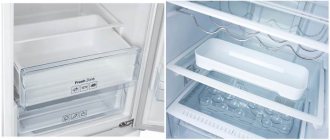How to transport a refrigerator is a problem faced by owners of newly purchased equipment and old units. The cooling system, which is sensitive to shocks, temperature changes, and impacts, may fail if delivered incorrectly. There are requirements for the placement of units in the car, speed limit and position. In order not to take risks and not spend money on repairs, it is better to order transportation of the refrigerator by car from a logistics company.
Why is it important to transport your refrigerator correctly?
In appearance, the refrigerator does not seem as vulnerable as it really is. It is not for nothing that refrigerator manufacturers insist that any refrigeration equipment should be transported only vertically. This condition is explained by the internal design of the device. The main part of the refrigerator is the cooling system, which is located both inside and outside the body. It consists of two main parts:
- evaporator – installed in the housing;
- capacitor - located on the back wall.
When the refrigerator is connected to the network, a special gas, freon, continuously circulates through the system pipes, which ensures the cooling of the products inside. The system works according to the following scheme:
- Special freon gas is supplied from the evaporator to the compressor.
- The compressor compresses the freon, after which it enters the condenser.
- The condenser converts gas into liquid, releasing heat.
- The liquid is sent to a special filter, which converts it back into gas.
- As the liquid turns into gas, the refrigerant boils and the internal chambers cool evenly.
Then the cycle repeats. If at least one part of the system is damaged, the circuit will stop working and the refrigerator will not perform its main function.
If the equipment is not positioned correctly during transport, the risk of breakage will be obvious as the main part will be in a vulnerable position. It is extremely important to know the structure of the system in order to protect the unit from damage during transportation.
Determining the exit of the cooling tube from the compressor
All refrigerators operate on similar principles. The refrigerant, which is in a gaseous state, is moved by a motor to the condenser. Here it gives off the heat that it picked up in the cooling chamber, after which it turns into liquid. In order for a person to understand through which tube freon moves from the engine to the condenser, a person needs to turn on the refrigerator and, at the moment when gases and liquids begin to move through the internal mechanisms of the unit, touch the tubes that extend from the compressor. Here you need to focus on their temperature. The tube that is warmer (sometimes even hot) leaves the compressor towards the condenser. This is the item you are looking for. When transporting the refrigerator in a horizontal position, the found tube must face upward so that oil does not get into the internal mechanisms of the unit, and, accordingly, so that the refrigerator does not fail.
On some models, all pipes are located in one part of the engine. Moreover, on the first turn they will have the same direction. Accordingly, when the refrigerator is placed in a horizontal position, they will all face up. This greatly simplifies the task of transporting equipment for carriers. A person does not have to recognize the direction of movement of working fluids.
Note! During operation, the tube can reach high temperatures. To avoid getting burned, it is recommended to touch the parts of the device with great care.
Preparation for transportation
Properly organized transportation includes not only the appropriate placement of the refrigerator in the back of the car, but also its preliminary preparation. Please pay special attention to this issue, as preparation may take some time.
Action plan:
- Disconnect the device from the electrical network.
- Unload the chambers by removing not only the products, but also small parts (shelves, drawers, partitions).
- Defrost the refrigerator.
- Thoroughly wipe the walls of the internal chambers with a dry towel.
Only after completing these steps can you begin packing the equipment.
How to pack a refrigerator before transportation
Procedure:
- Fold and pack shelves, dividers and drawers separately. Shock-absorbing film is perfect for this purpose. Pay special attention to glass parts.
- Close the doors and secure them. A prerequisite is that each door must be attached to the body in at least two places. To secure, use a rope or wide tape.
- Secure the compressor. The best option is special bolts for transportation, which are usually factory assembled. If these parts are missing, use rope or wide tape.
- Strengthen the clamping of the compressor. Any shaking on the road can cause a breakdown, even if you carry the refrigerator in an upright position. To avoid this, fill all the free space around the compressor with crumpled paper. Do not use foam for fixation, as some sources advise. When the foam hardens, it expands and can cause damage to parts.
- Twist and attach the power cord to the body.
- Pack the cooler. To prevent damage to the body, cover all walls with foam or cardboard and secure with tape or rope. If you don't have the right amount of packaging material, attach foam in the corners.
Having a factory box will greatly facilitate the transportation of large kitchen appliances.
Secrets, life hacks, nuances
We pack correctly
Proper preparation for transportation is a guarantee of a successful outcome of the cargo transportation operation.
- Initially, the refrigeration equipment must be turned off, all products removed from the chambers, including frozen ones from the freezer, defrosted and dried thoroughly.
- If you do not have fasteners or spacers, you must remove all shelves, pallets and drawers;
- Secure the compressor as best as possible. Some models have special transport bolts for this. If they are not there, cardboard and polystyrene will help you. Be sure to remove the bolts before using.
- Be sure to secure the door. It doesn’t matter what it will be - rope, tape or special tightening belts;
- Purchase special packaging material (bubble film) and wrap your refrigerator in several layers. Or perhaps you still have the original packaging and foam - this will be the best solution.
These recommendations are standard and apply to any type of refrigeration equipment: two-door, built-in, stainless steel, freestanding freezers and others.
Recommendations for the driver-carrier
If you order cargo transportation, warn the driver about the presence of refrigeration equipment in the cargo, because not all cars are suitable for this. Moving such a bulky but fragile device requires certain preparation and conditions:
- First you need to determine whether the height of the awning allows you to transport the unit vertically. If not, you will have to lay it on its side or transport it at an angle;
- Consider mounting options to securely fix the device. This could be some things, upholstered furniture, a washing machine. If the car is equipped with special stops and clamps, this is an ideal option;
- It is necessary to put a shock-absorbing layer on the floor of the cabin (cardboard, polystyrene foam, isolon, etc.);
- The maximum travel speed is 60 km/h, but 40 km/h is better;
- Choose a smooth, proven road. Drive away smoothly and avoid sudden braking.
We take it out of the apartment correctly
Pay special attention to the method of removing the refrigerator from the apartment. If you plan to move the refrigerator horizontally, before packing the device, determine where the freon supply tube to the compressor is located. It is very important to rotate the carrying case so that this tube is at the top. Otherwise, engine oil may mix with freon, resulting in engine malfunctions. When lowering the refrigerator vertically down the stairs, make sure that the compressor is located at the bottom. Similar conditions must be observed when lifting the refrigerator into the apartment.
It is worth noting that one person will not be able to remove a large unit from the apartment. It will be convenient to carry the equipment together or with the help of a special trolley.
Each refrigerator receives an individual approach
Refrigerator transportation services must be provided in accordance with all the rules, otherwise the equipment can be easily damaged. Transporting a refrigerator with loaders is quite a risky business if people without experience take on the job. But it will be difficult to notice a breakdown and prove that it is a consequence of improper transportation.
Or relying on your own strength and simply ordering a car to transport the refrigerator is a big mistake. Entrust this task to experienced professionals - Attic movers who know how to properly transport any household appliances.
Car transportation methods?
The body of a car or truck may not fit the dimensions of the device. It is permissible to transport a refrigerator at an angle or horizontally, but only if certain conditions are met.
Whatever position you install the equipment in the car body, fixing the body is mandatory.
Determine where the freon supply tube is located
When transporting the refrigerator on its side, you must first determine where the tube supplying freon to the compressor is located. These steps must be followed to ensure that the cooling system does not fail after transportation.
According to standards, the compressor of household refrigerators is equipped with freon supply tubes, which can be located on one or both sides.
If the freon tubes are located on one side, there will be no problems, just place the refrigerator on the opposite side.
If the tubes diverge on both sides, you need:
- Look at the instructions. Sometimes the manufacturer specifies which side the equipment should be transported on. The left and right positions are determined by looking at the front of the case.
- Determine which tube is the discharge tube and install the device so that this tube is at the top.
To understand which tube is the discharge tube, look at the markings on the housing or the compressor itself. The inscription “Outlet” with a directional arrow indicates which side the discharge tube is located. The inscription “Inlet” or “Suction Connector” with a directional arrow indicates that this tube is on the opposite side.
If there are no markings, you can determine the location of the tubes yourself. To do this, connect the previously disconnected device to the electrical network, and test both tubes by hand for 1–2 minutes. The one that heats up more will be the pressure one.
Vertical placement
You can install the refrigerator vertically only if the dimensions of the car body allow it. This option is possible if the height of the body exceeds the height of the device by at least 30 cm.
To reduce possible damage, secure the refrigerator with shipping straps, and to avoid vibrations and vibrations, place cardboard or fabric underneath for shock absorption. If you are transporting both equipment and furniture, you can secure the refrigerator with soft parts or bales of home textiles.
Inclined
The option is considered more dangerous, but can be used if there are no other methods. Having installed the refrigerator in this position, it is extremely important to fix it correctly. Make sure that the slope is no more than 40 degrees, and that the driver drives as slowly as possible and tries not to get into a bump or hole. Otherwise, if the device falls, damage is inevitable.
Horizontal placement
This transportation option should be used only in desperate cases. In this case, leaving the device in a horizontal position is permissible for a maximum of 30 minutes. If transportation takes longer, do not take risks and choose a car that is suitable in size.
It is extremely important to follow the rules for horizontal transport:
- Cover the bottom of the body with a blanket or cardboard. The substrate should not be smaller than the device. This is the only way you will provide the necessary shock absorption during vibrations and vibrations during the journey.
- Secure the refrigerator. Fixation will help to avoid the refrigerator moving in the body space during sharp turns and braking.
- Choose the “right” wall. Carry out the manipulation before you pack the device. Place the refrigerator on its side so that the discharge tube is on top.
- If you are bringing new equipment, read the information on the box. The optimal position of the case during transportation will be indicated here.
Can the refrigerator be transported on the front or back?
Do not place equipment on the door or back. If you place the refrigerator on the front, the doors may become warped. If it is on the rear wall, the risk of the cooling system failing will increase.
Special trolley for transportation
The standard cart is equipped with special safety belts, a handle and stable wheels. Please note that for transportation on stairs it is better to use a trolley with three wheels, and for an elevator - with two. There is no need to buy a cart; the device can be rented.
By car
If its dimensions allow, you can transport a refrigerator in a passenger car. It can be used as a salon, trunk or roof rack.
Placing the device inside the car is the worst option. The refrigerator will not fit completely on the seat, which is why you will have to open the door. As a result, it will be impossible to look in the rearview mirror, plus you will create interference on the road.
If you want to transport the refrigerator on the trunk, place the body on a suitable side and secure it tightly. Avoid maneuvering, high speed, sudden braking and turning.
The optimal method of transportation is in the trunk of a car. If the housing does not fit completely, lay it in the direction of travel with the compressor forward, and secure the outer part with rigging slings. Be careful when driving as it may make it difficult to see in the rear view mirror.
Rules for transporting a refrigerator after purchase
It is easiest to transport a refrigerator from a store, because you will not need to worry about preparing and packing it. Usually stores deliver large household appliances, but it happens that the buyer takes care of the transportation himself.
If you decide to transport the new refrigerator yourself, select a vehicle that is suitable in size so that you can install the device in a vertical position. Otherwise, if you transport the refrigerator horizontally, the seller’s warranty obligations will become void.
It's better to leave everything to a pro
As has already become clear, transporting a refrigerator is not an easy story. If you don’t know how to do it correctly, you can damage the refrigerator so much that you’ll have to repair it at great expense. And the most unpleasant thing is that during the renovation you will have to live without a refrigerator, which is not very comfortable in both winter and summer. To protect yourself from mistakes, waste of effort and time, contact experienced specialists.
Transporting a refrigerator with movers you don’t know does not guarantee its safety. It is better to entrust such complex work to movers; they know exactly how to transport household appliances correctly.
The Attic works very simply: you place an order on the website, through an application or through social networks and the Attic movers come to you at a time convenient for you. They themselves will securely pack the refrigerator according to all the rules, carefully load it into the car and take it to a new address or warehouse, if necessary. You can order the transportation of your refrigerator in just one click!
When to turn on the refrigerator after transportation
If you turn on the refrigerator immediately after transportation, the cooling system may fail. Do not connect the refrigerator to the electrical network for a while. Which one depends on the model, brand and outside temperature.
As you know, there is liquid freon inside the cooling system, and oil in the compressor. During vibrations and shaking, liquids are agitated and moved through the system tubes. If the refrigeration equipment is turned on ahead of time, the oil will mix with freon and the system will fail.
The time during which the refrigerator must “settle” depends on the method of transportation. If the move was carried out in the summer, warm spring or autumn, and the refrigerator was transported vertically in the back, it is not recommended to turn it on for 4 hours, and if horizontally, for at least eight hours. Some models need to be left unplugged for longer. You can find exact information in the instructions.
If you are transporting a refrigerator in winter
In winter, it is colder outside, which means that the oil inside the compressor may freeze during transportation. Condensation may also form on the motor contacts due to sudden temperature changes. It is important to wait until the oil warms up to room temperature and the condensation evaporates, so the time the refrigerator is left unplugged at room temperature must be increased.
If you transported the refrigerator vertically, it should stand for at least 8–12 hours, and if horizontally, it should stand for at least 48 hours.
What problems can occur if the refrigerator is transported incorrectly?
According to service workers for large kitchen appliances, a third of refrigerator breakdowns occur as a result of improper transportation.
If after transportation the refrigerator does not turn on or problems appear in its operation, try to determine the cause of the failure yourself.
The compressor in the new refrigerator does not turn on
The following problems can cause similar consequences:
- manufacturing defect;
- electrical wiring violation;
- engine damage.
If problems occur, contact the service center using the warranty card. If there is no warranty, call a service technician and do not attempt to repair the equipment yourself.
The new refrigerator does not freeze, but the compressor turns on
If the compressor turns on, but the refrigerator does not freeze, most likely the cooling system has depressurized. This happens if the system tube has been torn or cracked, causing the refrigerant to evaporate. It is necessary to find the leak, repair the system and refill the freon.
Doesn't turn on
If the device does not turn on at all, it means that the cooling system, thermostat or electrical wiring inside was damaged during transportation. It will be extremely difficult to determine the cause of the breakdown on your own without the proper experience and knowledge.
The engine may have seized. Try turning off the refrigerator for a few hours and turning it on again. If this does not help, call a specialist.
After transportation, ice or snow began to form in the chamber
Such consequences are possible if the sealing of the chambers has been broken. Seals, rubber bands, door hinges, and external body elements could be damaged by vibrations and shaking while the car is moving. To fix the problem, check the integrity of all external elements and fix them. If this does not help, call a technical service representative.
The compressor does not turn on in a used refrigerator
If the refrigerator was working properly before moving, and then the compressor stopped turning on, it is possible that sediment in its lower part mixed with oil. You can solve the problem by warming up the engine with a hair dryer or fan heater for 20–25 minutes. If this does not help, you will have to seek professional help.
The main or freezer compartment began to work worse
Similar consequences are observed if a plug has formed in any part of the system, which can only be removed by a qualified technician.
It is worth noting that in double-circuit refrigerators the causes of such a breakdown may be:
- refrigerant leak in one of the circuits;
- malfunction of the camera temperature sensor;
- malfunction of the thermostat.
A breakdown that occurs due to such reasons can only be repaired by a specialist.
The old refrigerator started to get very cold
If the evaporator was covered with ice, it melted during transport and the system began to work as it should. There is no need to fix this problem, just adjust the sensor to the optimal temperature.
The old refrigerator does not freeze, the compressor works
Such problems can arise due to two reasons:
- a plug of sediment has formed in the cooling system at the bottom of the compressor;
- A refrigerant leak has occurred due to a compromise in the integrity of the system.
In both cases, only a specialist can fix the problem.
Recommendations for drivers and delivery workers
It is worth noting that the correct transportation depends not only on the method of preparation, packaging and location of the refrigerator in the body. Delivery drivers must also have the appropriate knowledge. Basic Rules:
- do not allow the device to shake on the way, reducing the speed to 40–60 km/h;
- try to avoid bumps and holes on the road;
- Avoid sharp turns and braking, which could cause the refrigerator to hit the sides.
If you decide to transport the refrigerator, it is better to worry about a suitable truck in advance in order to install the device in the correct vertical position. If there is an urgent need to transport the refrigerator in a horizontal position, do it in compliance with all regulations. Properly prepare, pack, secure, and then turn on the unit, and the risk of cooling system failure will be minimal.
General transportation rules
The need to move the refrigerator may arise if:
- a person bought a unit in a store and plans to save on delivery to his home;
- a family moves from one apartment to another;
- We plan to transport the refrigerator to the dacha or to friends.
Full information about possible modes of transportation is mainly found in the instructions.
According to those organizations that produce refrigerators, units should be transported in a standing position and not in a lying position. This is due to the fact that there is oil in the compressor. If the refrigerator is transported in a lying position, it may spill out and enter the heat exchanger. This is fraught with unpleasant consequences, including failure of the unit, which means additional financial losses.
After loading into the car van, the refrigerator must be installed in a strictly vertical position, after which it is securely secured using locking devices. This is done to ensure that the equipment does not move around the premises during transportation. Otherwise, the unit may also fail by hitting the wall of the van.
Note! If the refrigerator is not secured, only an iron box will arrive at its destination, which remains to be turned over for metal.
However, a person cannot always adhere to these rules. Especially when you need to transfer a large unit with a height of more than 2 meters. Not all vans can accommodate such a refrigerator. The upper part of the machine does not have the necessary dimensions. In this case, it is physically impossible to place the equipment in a vertical position.
This is where a person begins to wonder how to transport a refrigerator in a horizontal position. After all, there is no other way to move the equipment. Device manufacturers have also developed a number of recommendations in this regard. By completing them, the owner will be able to bring his refrigerator to its destination in good condition.
Modern refrigerators equipped with the No Frost system are associated with a number of transportation difficulties. They can only be transported in a strictly vertical position. If you ignore this requirement, a simple iron box that does not carry any useful functions will reach its destination. This is due to the structural features of the internal mechanisms of refrigerators of this type. If they are transported horizontally, the motor may break off the inner spring. Only specialists can correct this damage.
At the same time, we should not forget that even if the equipment was transported in compliance with all existing rules, after it was brought to a new place, it cannot be immediately turned on. It should stand for some time. For refrigerators, this indicator varies from 2 to 24 hours. No Frost units can be turned on half an hour after the end of transportation. During this time, the oil that was displaced during transportation has time to return to the engine. If the refrigerator is turned on before this time, the motor will begin to heat up and fail, and the unit itself will cease to perform its freezing functions.
The most durable refrigerators are considered to be Soviet-made units. As practice shows, they are able to survive more than one generation, continuing to properly perform their functions.
However, the transportation of such refrigerators also has a number of features. They cannot be transported on the back or side. It's all about the design features. The units are equipped with a heavy compressor. Often a good vibration is enough to cause them to come off their mounts. Finding a specialist to repair this type of refrigerator is not easy these days.
Passenger cars are often used to transport such refrigerators. In this case, certain skills are required from the driver in order to bring the unit to its destination intact and safe. You should try to avoid uneven roads and avoid making sharp turns. When manually moving the unit from a vehicle to an apartment, great care should also be taken. The refrigerator must not be thrown or moved suddenly.
Soviet refrigerators are also not recommended to be transported in winter. As a rule, such units contain obsolete oil. All the time it becomes more viscous. At negative temperatures, the viscosity of the substance increases. Accordingly, there are more chances that Soviet refrigerators will fail after transportation in winter than modern models. This is primarily due to the age of production. Moreover, many owners do not bother to carry out the necessary maintenance of old refrigerators at home.
However, transportation of any equipment in winter has its own characteristics. This statement applies not only to refrigerators, but also to other devices. This is a complex process that requires increased attention.











